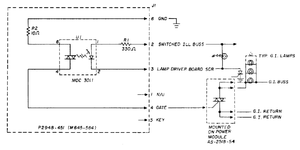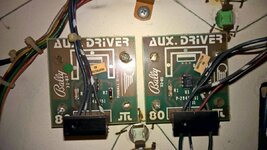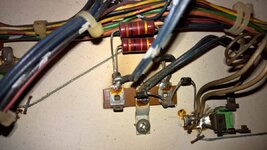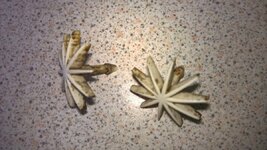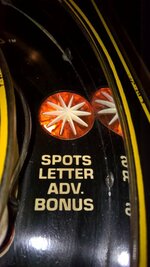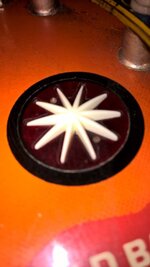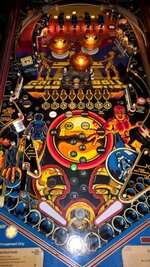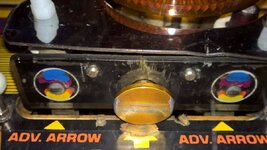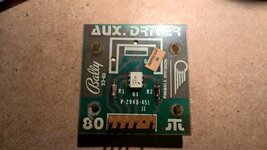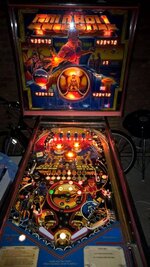Pinball info
You are using an out of date browser. It may not display this or other websites correctly.
You should upgrade or use an alternative browser.
You should upgrade or use an alternative browser.
Gold Ball - Intermittent Problems
- Thread starter astyy
- Start date
TRIACS identified, they are on plug in connectors so easily swapped over for a test. Annoyingly, the cables to the Aux flashers aren't long enough to allow me to swap them over so will have to remove and swap the cards themselves (only a couple of screws each but over-running lunch break).
What I don't understand is that when I unplug both Aux flashers together everything stays flashing in lamp test mode (apart from BB GI still not working)?
Whilst doing this fiddling the 0A string of BB feature lights are back on again but I've now noticed that G Arrow and L (of GOLD) Arrow feature lights are out on the PF - most likely a duff SCR on A3 as these are close on the PF. On the smudgy online manual they appear to both be on A3 J1 -23 controlled by Q6? Can you confirm this please @Nedreud you did promise me some hi-res scans
What I don't understand is that when I unplug both Aux flashers together everything stays flashing in lamp test mode (apart from BB GI still not working)?
Whilst doing this fiddling the 0A string of BB feature lights are back on again but I've now noticed that G Arrow and L (of GOLD) Arrow feature lights are out on the PF - most likely a duff SCR on A3 as these are close on the PF. On the smudgy online manual they appear to both be on A3 J1 -23 controlled by Q6? Can you confirm this please @Nedreud you did promise me some hi-res scans
I've ruddy well misplaced my manual! ARRRRGGGGHHHHH!!!!
I borrowed a hand scanner but no matter how careful I was the schematics always look a bit "wobbly". Will dig out my flatbed scanner soon... it's buried at the back of the storeroom!
I borrowed a hand scanner but no matter how careful I was the schematics always look a bit "wobbly". Will dig out my flatbed scanner soon... it's buried at the back of the storeroom!
I've ruddy well misplaced my manual! ARRRRGGGGHHHHH
Isn't that always the way! If the scanning is a faff, the A3 lamp/solenoid schematic online is one of the hardest to read, particularly the areas that show the traces to the SCRs. It's normally a process of elimination based on what is legible and some liberal DMM'ing.
Whilst doing this fiddling the 0A string of BB feature lights are back on again but I've now noticed that G Arrow and L (of GOLD) Arrow feature lights are out on the PF - most likely a duff SCR on A3 as these are close on the PF.
I'd thought it more likely to be a bad connection or blown bulb...

Good point, @Moonraker. Check the simple and most likely problems before breaking out the big guns!
The bulbs are def good. I'll check the SCR as that's pretty straightforward and I've had this before with related PF lamps.
It's the BB GI out that's bugging me, I don't like several things going wrong at the same time.
It's the BB GI out that's bugging me, I don't like several things going wrong at the same time.
also try swapping over the GI FLASHER MODULES, both of which are mounted on the back of the light board
It's dead handy owning the same machine as you @Nedreud - I'd recommend all noobees consider a Gold Ball, Paragon or Vector!
Anyway a result following the above suggestion - swapped the GI Flasher PCBs (AS-2518-68) over and we have life back in the BB GI and the PF GI is now out as expected. I didn't have much time to investigate further but that module doesn't consist of much a couple of resistors (testing good) and an Opto MOC3011. At the moment I'm not sure which PCB controls what as the schematics are vague in this area. I'll investigate in more detail later it may be a simple header reflow if I'm lucky else could try replacing the MOC3011 - they are cheap as (micro)chips (sorry)
The GI FLASHER modules sure are simple! Seems to me that by swapping them over you've pretty much proved one of them is defective. There's a whole family of the TRIAC OPTOCOUPLERS and just about any of them would do the job: http://www.farnell.com/datasheets/1806097.pdf They should cost around 50p each.
You may notice of the back of the light board next to the module is a #44 or #555 lamp. This is to provide a minimum load for the SCR on the LAMP DRIVER MODULE. Make sure they aren't dead!
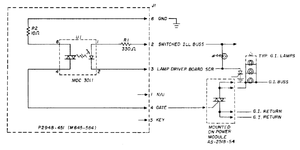
As for the TRIACs mounted on the POWER MODULE... looks like you're lucky and both of yours are good. I have a sneaky suspicion one of mine is dead. Just been doing some research in equivalent replacements as the original Motorola MAC38-2 are very obsolete. I found on Pinside a recommendation that an BTA25-600BW would make a god replacement and is considerably higher rated but with similar operating characteristics. Only £6.49 posted from eBay! http://www.ebay.co.uk/itm/371116160261
You may notice of the back of the light board next to the module is a #44 or #555 lamp. This is to provide a minimum load for the SCR on the LAMP DRIVER MODULE. Make sure they aren't dead!

As for the TRIACs mounted on the POWER MODULE... looks like you're lucky and both of yours are good. I have a sneaky suspicion one of mine is dead. Just been doing some research in equivalent replacements as the original Motorola MAC38-2 are very obsolete. I found on Pinside a recommendation that an BTA25-600BW would make a god replacement and is considerably higher rated but with similar operating characteristics. Only £6.49 posted from eBay! http://www.ebay.co.uk/itm/371116160261
Attachments
Thanks @Nedreud - the two flasher boards are daisy chained and its not obvious to me which bulbs are maintaining the load. That aside though, hasn't my switching the connector plugs over test moving the problem from BB to PF negate a failed bulb and prove the problem is on the flasher PCB itself? Dry joints, failed MOC3011 or similar.
Those power resistors and diodes are here on the schematic (WIRING DIAGRAM BACK BOX in the manual):
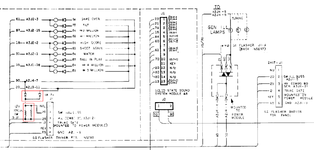
These GI flashers are a nightmare on the schematics. The TRIACs, modules and connectors appears on several diagrams. Once I've wrapped my head around the circuit I'm going to draw a picture that actually correlates with the real world.

These GI flashers are a nightmare on the schematics. The TRIACs, modules and connectors appears on several diagrams. Once I've wrapped my head around the circuit I'm going to draw a picture that actually correlates with the real world.
WIRING DIAGRAM BACK BOX in the manual
Please tell me that diagram is from the ipdb manual! So no wonder I'm confused, I can't even make out on the schematics that there are two of these GI Flasher boards. As you say they are daubed across several diagrams.
So that's interesting as the GI Flashers are connected to the BB feature lights and per my earlier ramblings the 5 of these all on the 0A phase circuit so possibly related - these have since come back on (on their own). Is it these feature lights then that present the load to the SCR for each MOC3011?
No. Look at the previous schematic. There us a #44 lamp across pins 2 and 3 of the flasher module labelled SWITCHED ILL BUSS and LAMP DRIVER BOARD SCR. The SCR is also in that diagram but dangles just above the TRIAC and going to a ground connection. Very badly drawn as all so close together. Somewhere on the back of the light board there is a bulb on its own facing inwards. Thus is the dummy load for the SCR as the LED that is in the MOC3011 doesn't present enough current to hold the SCR. This is exactly the same problem with using LEDs in feature lamps. Basically what they're doing is using a feature lamp SCR that would normally control a single lamp to control an LED instead. That LED is in the MOC3011 which is an optical isolating device for turning high current TRIACs on and off. The TRIAC is then used to open and close the the ground connection for all the GI lamps. Voila! MPU-controlled feature lamp channel can turn the entire GI on and off without any mods to either the MPU or LAMP DRIVER. Just connect the output of the LAMP DRIVER channel to little extra flasher module and hook that up to a whopping big TRIAC! Quite clever really 
Looking more closely at the schematic it appears as though both flasher modules are controlled by the same lamp driver SCR as both are labelled as connected to A3J1-21. I had assumed that as there are two TRIACs each would be controlled seperately but apparently not. I guess there are two TRIACSs either because they wanted to split between backbox and playfield GI or because back in 1984 they were the biggest TRIACs ffor the job without getting super expensive.
Or maybe I need to stop trusting the crappy manual and just look inside the machine itself!!!
Or maybe I need to stop trusting the crappy manual and just look inside the machine itself!!!
You warned me of such in your very first message to me!I need to stop trusting the crappy manual
Looking at the A3 schematic they list the flasher twice on J1-21 as though its on 0A and 0B like any other SCR controlling two feature lights. This page isn't clear in the online manual so difficult to read but it looks like it's leading to Q8.both flasher modules are controlled by the same lamp driver SCR as both are labelled as connected to A3J1-21
Today's mission is to find this and re-flow the flasher boards.There us a #44 lamp across pins 2 and 3 of the flasher module
B
backbox
The GI flasher schematic showing the #44 is just a generic diagram detailing the opto. That's why there's no wire no.s or connectors shown. Also, it was drawn a couple of years before the game was made!
The bulb(s) may have been replaced with the 2x R that you already identified.
Rob
The bulb(s) may have been replaced with the 2x R that you already identified.
Rob
Last edited by a moderator:
No joy with the re-flow so I want to replace the MOC3011, is this at Maplins any good?
http://www.maplin.co.uk/p/high-voltage-opto-isolator-ay44x
http://www.maplin.co.uk/p/high-voltage-opto-isolator-ay44x
Mmm... I'd want to know the part number or have the datasheet. These TRIAC optocouplers come in two flavours: Zero Crossing and Non Zero Crossing. If I recall correctly the MOC3011 is Non Zero Crossing. CPC don't have the MOC3011 (rated at 250V) but they do have the MOC3022 rated for 400V. I think it would be a suitable replacement: http://cpc.farnell.com/fairchild-semiconductor/moc3022-m/optocoupler-triac-driver/dp/SC12309No joy with the re-flow so I want to replace the MOC3011, is this at Maplins any good?
http://www.maplin.co.uk/p/high-voltage-opto-isolator-ay44x
Or get a MOC3011 posted from eBay: http://www.ebay.co.uk/itm/321681250598
I contacted Maplin. It's a 4N25, which is a transistor optocoupler, not a TRIAC optocoupler. I'd give it a miss for a better match. Looking at the datasheet it needs 5 of the 6 pins connecting as internally it uses a transistor as the switch. The MOC3011 only uses 4 pins as the switch is... you guessed it... a TRIAC! I also think this is important as the load is AC.
Thank you for going to all that trouble - I just wanted to crack on with the job. I'm sure eBay is the route this one is same brand as FarnellI contacted Maplin
http://www.ebay.co.uk/itm/FAIRCHILD-SEMICONDUCTOR-MOC3011-M-OPTOCOUPLER-TRIAC-DRIVER-/181209684317
The afternoon wasn't wasted this rust has been bugging me for a while, the 2nd picture doesn't do it full justice.
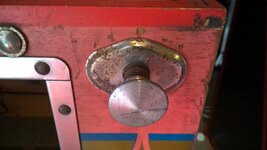
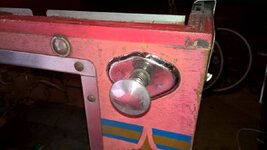
OMG! The grot on those star rollovers! 
Rest of the playfield is looking sweet, really sweet!
Rest of the playfield is looking sweet, really sweet!
A small job on the cards for today. Some kind soul on here spotted my machine was missing the power switch safety cover and kindly sent me one - shine on @Jay Walker
Here it is fresh out of the bath
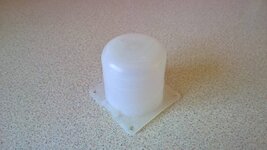
the exposed switch (yes I did give the base plate a bit of a clean)
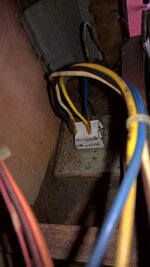
much better - very happy not sure where I could have bought this part
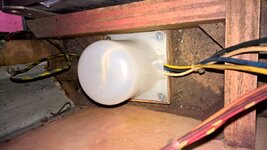
Here it is fresh out of the bath

the exposed switch (yes I did give the base plate a bit of a clean)

much better - very happy not sure where I could have bought this part

@Jay Walker thought it was my GB missing it's cover so I ushers him in your direction  What a nice man. Very nice man.
What a nice man. Very nice man.
Thanks, fellas.
Bit of GOLD BALL attention needed tonight, @Nedreud is going to visit soon for an inspection so all must be tip top.
The top L and Y lane feature lights have been intermittently sticking on and increasingly so- fortunately when I got the machine the P and A lights were stuck on so I had a fair idea where to start. Referring to the manual these are both driven by SCR Q22 on the lamp/solenoid driver board, that's this fella and the SCR bank is top left. On this machine a single SCR drives a pair of feature lamps on two phases 0A and 0B.
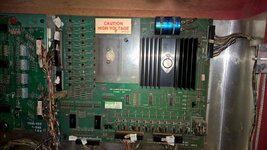
The SCR tested ok per the rest in the bank, but as it was an intermittent problem and I had one in my spares thought it was worth swapping out first anyway. Also wanted an opportunity to replace the PCB stand offs and fill any missing with those I got recently from @myPinballs. This must be what Jim was talking about - spot the new one!
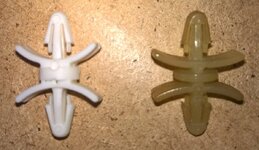
With the board out the plane behind looks like this which appears shiny but on closer inspection is like a foil covered cardboard - note new stand offs in position, the PCB attaches by these and bolts to ground points in both corners.
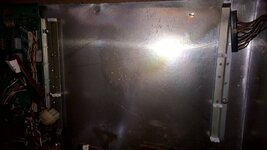
Q22 replaced and PCB back in - note white stand offs poking through
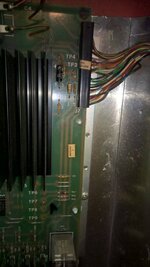
Problem fixed! L and Y lights now switched OFF when they should be.
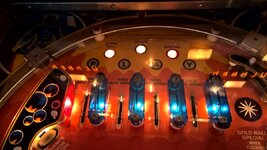
The top L and Y lane feature lights have been intermittently sticking on and increasingly so- fortunately when I got the machine the P and A lights were stuck on so I had a fair idea where to start. Referring to the manual these are both driven by SCR Q22 on the lamp/solenoid driver board, that's this fella and the SCR bank is top left. On this machine a single SCR drives a pair of feature lamps on two phases 0A and 0B.

The SCR tested ok per the rest in the bank, but as it was an intermittent problem and I had one in my spares thought it was worth swapping out first anyway. Also wanted an opportunity to replace the PCB stand offs and fill any missing with those I got recently from @myPinballs. This must be what Jim was talking about - spot the new one!

With the board out the plane behind looks like this which appears shiny but on closer inspection is like a foil covered cardboard - note new stand offs in position, the PCB attaches by these and bolts to ground points in both corners.

Q22 replaced and PCB back in - note white stand offs poking through

Problem fixed! L and Y lights now switched OFF when they should be.


